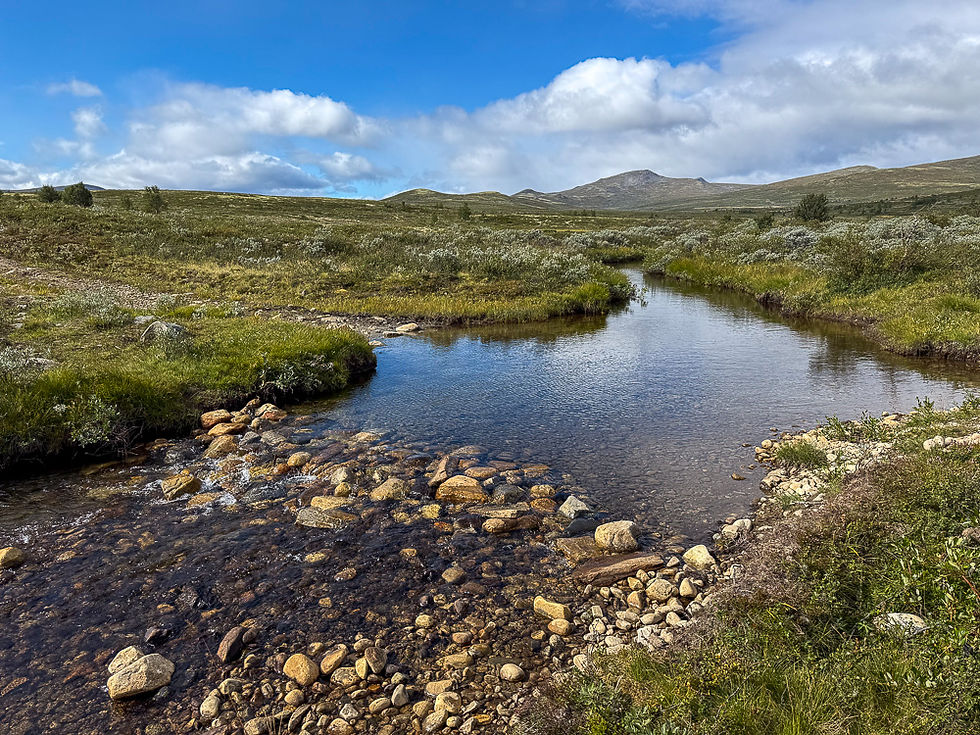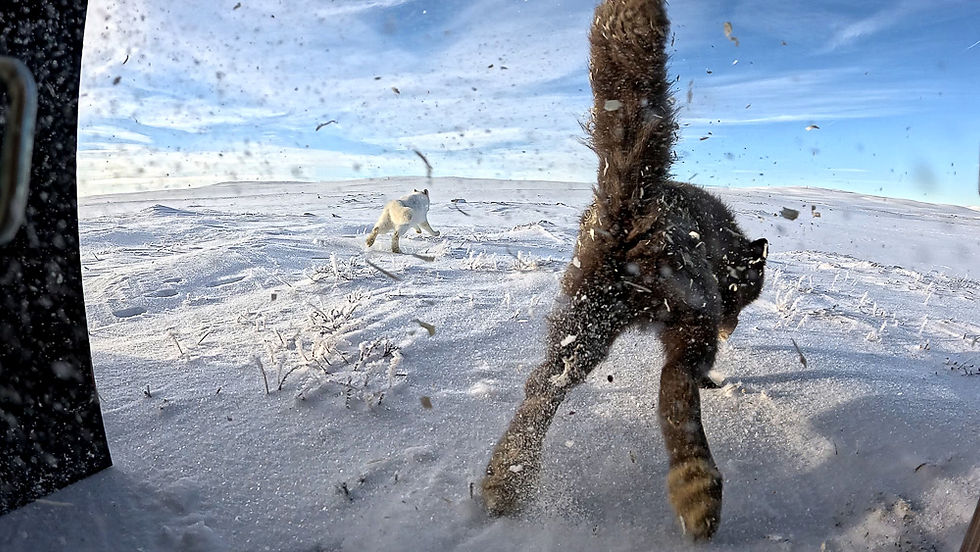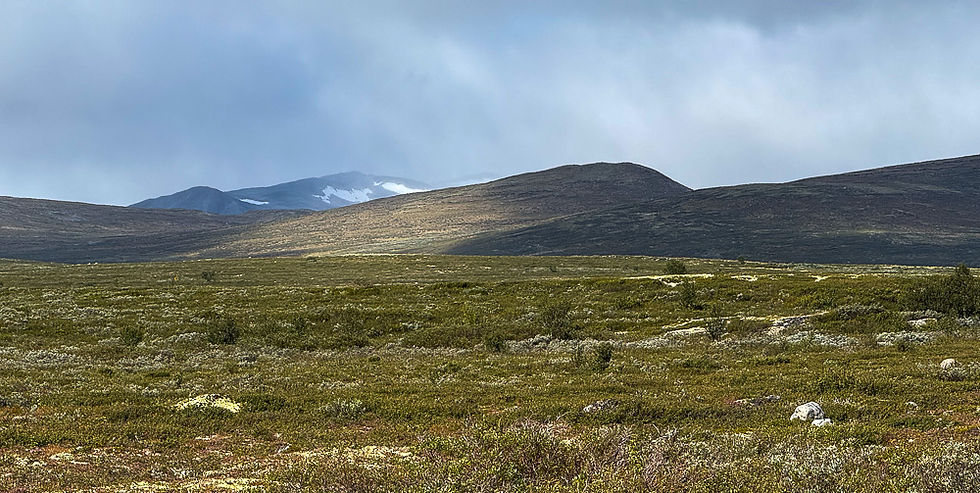Arctic foxes on Dovrefjell - project for rewilding arctic foxes - hope for the future
- Admin

- Sep 29
- 9 min read
The Arctic fox was on the verge of extinction in Norway. In 2005, a breeding station for arctic foxes was established on Sæterfjellet near Oppdal. Since then, the project for rewilding arctic foxes has multiplied the population in Norway. The goal is to achieve a sustainable viable population in several mountain areas. The Norwegian project also contributes to increasing the population in Sweden and Finland because some animals migrate there, but there is also a Nordic project to increase the number of arctic foxes throughout the Nordic region.

In the 19th century, there was a large population of arctic foxes throughout the Nordic region. The arctic fox, also called the polar fox and the Arctic fox, is particularly admirably adapted to the climate in the Arctic regions and in the high mountains of the north. No other mammal has such good heat-insulating fur as it. Since there was also a good supply of small rodents, conditions were well suited for the arctic fox in many of our mountain areas.

However, from the late 19th century and early 20th century, unregulated and intense hunting led to a drastic decline. This trend was further exacerbated as extensive natural encroachment reduced and fragmented the animals' habitats. In recent decades, several other factors have come into play. After wolves and wolverines were removed from the arctic fox's habitat, it became more difficult for it to survive because these predators previously killed prey that the arctic fox could eat the remains of in the winter when it was difficult to find other food. Climate change has also created problems.

The Arctic fox was protected as early as 1930 and has been so ever since. But despite protection and other protective measures, it has not been possible to reverse the trend. At the beginning of the 2000s, the situation was critical. At that time, there were only between 40 and 60 Arctic foxes left in the entire Nordic region, and the Arctic fox was classified as critically endangered on the Red List. In many mountain areas, such as Dovrefjell, the Arctic fox was extinct.

In 2005, a rewilding program was therefore initiated by the Norwegian Institute for Nature Research NINA with the aim of breeding and releasing arctic foxes both in areas where they had been extirpated and where they were critically endangered. This breeding program has developed methods for breeding arctic foxes in captivity and releasing arctic fox pups. Fortunately, this project gives reason for optimism.
In 2024, the breeding program had released a total of 494 arctic foxes since its inception. These pups had been distributed to nine different mountain areas throughout the arctic fox's habitat, which runs from the Hardanger plateau in the south to the Varanger peninsula in the north. In 2024, the adult arctic fox population was estimated to be somewhere between 303 and 365 individuals. In 2024, 64 litters of pups were observed. In total, there have been 568 arctic fox litters in Norway in the period from 2011 to 2024. Although this is promising, it is important to continue this work for a long time to come. Currently, the breeding program is planned to continue for 10-15 years. There are also several other factors that may make the future of the arctic fox uncertain.


Until populations become larger, size itself will be a problem. When populations are small, it takes little disease or accidents for the entire group to die out. Inbreeding is a major problem when you have small populations in limited areas. That is why the Arctic Fox Monitoring Program is important to ensure a viable population. In Scandinavia, there has already been a 25 percent reduction in genetic variation. If this trend continues, it may be difficult to maintain a healthy population.
Although the arctic fox has a fantastic ability to smell its way to groups of arctic foxes far from its own habitat, relatively few individuals move from one habitat to another. One reason is that the groups are too small to need emigration. Another is that natural encroachment and human activity have made it more difficult. The lack of exchange of individuals between habitats reduces genetic diversity. For now, only animals from the breeding project are being released, but it may be possible later to obtain new genes from populations elsewhere, for example by capturing some of the pups born in the wild, caring for them at the breeding station from August to January and releasing them again in another area. This could help increase genetic diversity and at the same time led to more individuals surviving since the mortality rate for pups born in the wild is high.

Since the arctic fox only lives for five years on average, the populations are highly dependent on regular small rodent cycles. It should preferably be a lemming year or a mouse year more often than every five years. Lemmings reproduce throughout the winter under the snow. Warmer winters with shorter periods of snow cover and more rain led to fewer lemmings. In this way, climate change can be a major threat to both lemming and arctic fox populations.
The goal of the breeding project is to increase the population to such a size that the individual subpopulations around the country can withstand periods with low availability of small rodents. At the end of the 19th century, approximately 2,000 arctic foxes were hunted per year. In the winter of 1880/1881, four hunters caught 400 arctic foxes on the Varanger Peninsula alone. This shows how large the population once was. In the breeding project, almost no arctic foxes were born in the period from 2000 to 2012 because there were poor small rodent years. However, the situation has changed in the last ten years. The population has increased significantly, and many litters of puppies have been born despite poor lemming years. This gives hope that it will be possible to achieve a sustainable arctic fox population that can fend for itself.

But until then, it must receive supplementary feeding. In 2024, a total of 131 feeders were set up throughout the arctic fox's habitat in Norway, except in Børgefjell. These are designed so that the red fox is unable to get food out of them. On average, just under 100 kg of dry food is filled per feeder annually. If the population of small rodents does not increase, supplementary feeding may have to continue for a long time. It is uncertain how long this will be necessary, but the goal is to be able to stop in about 15 years.

Climate change has given the red fox an advantage. As the tree line creeps upwards, the red fox's habitat is expanded, while the arctic fox is pushed further up into the mountains where opportunities for denning and access to food may be poorer. Human activity and cabin construction in the high mountains have also given the red fox greater access to food in the winter, thereby removing the advantage the arctic fox had. The red fox is nearly twice the size of the arctic fox and will therefore easily outcompete it. On the Varanger Peninsula, some red foxes are killed to give the arctic fox more space, but this is currently happening to a small extent elsewhere in the country.







Future for the Arctic fox
The vast tundra areas around the Arctic are home to large populations of arctic foxes, and arctic foxes are therefore classified as viable on the international Red List. The high mountains of Scandinavia lie at the edge of the arctic fox's range. These areas are more vulnerable to climate change, and populations here are still threatened, although the breeding program has led to the classification being improved from critically endangered to highly endangered on the Norwegian Red List.
Both Norway and Sweden have their own action plans to preserve and strengthen the arctic fox population. Norway has committed to ensuring that the arctic fox survives, and the arctic fox has been given priority status. The arctic fox project and breeding program at Oppdal are one of the most important measures to achieve this. The breeding program in Norway has also contributed to an improvement in Sweden and Finland because some animals from Norway have emigrated to our neighboring countries. A Nordic cooperation has been established to monitor and strengthen the arctic fox population in the Nordic countries.

Dovrefjell is one of the places where the breeding program and the release of arctic foxes and the rewilding of arctic foxes have been successful. It is also a popular area for hikers. When moving in these areas, however, it is important to remember that the arctic fox is protected, and that you are not allowed to pursue it or come closer than three hundred meters to it. It is also not allowed to stay closer than three hundred meters from the arctic fox's den.
Acknowledgements: The images of the arctic fox and the breeding station at Sæterfjellet near Oppdal in this article were provided by the Norwegian Institute for Nature Research NINA. I would like to thank project manager Craig Jackson for useful information and loan of images.
More rewilding: en.turideer.com/blank-3
More excursions: www.turideer.com




Comments